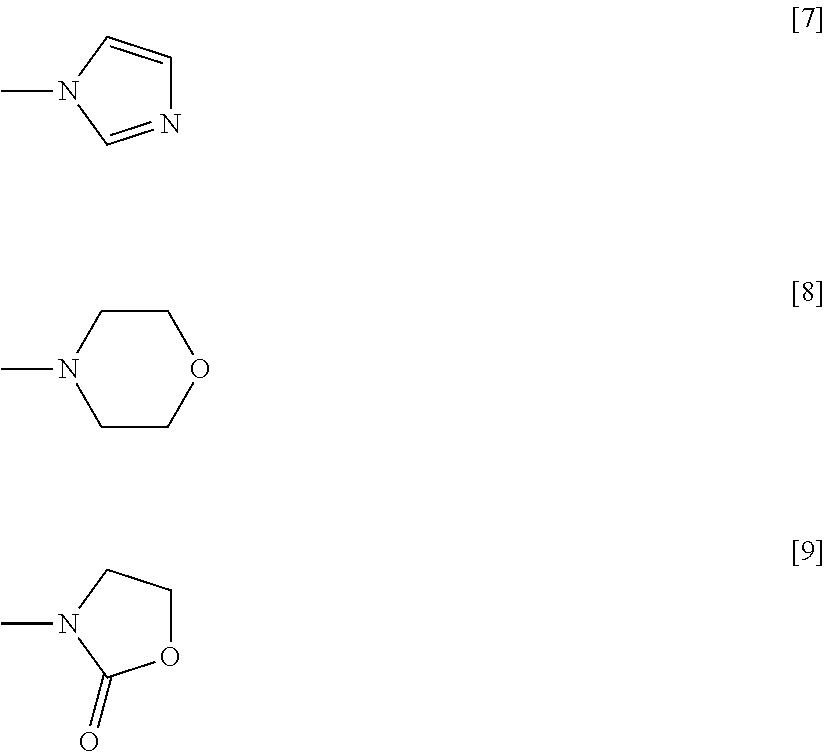Method of Preparing Liquid Chemical for Forming Protective Film
a protective film and liquid chemical technology, applied in the direction of cleaning using liquids, coatings, semiconductor/solid-state device details, etc., can solve the problems of increasing the aspect ratio, the damage to the wafer due to cleaning, and the basicity damage has been serious, so as to reduce the capillary force of the unevenly patterned surface, excellent water repellency, and good persistence
- Summary
- Abstract
- Description
- Claims
- Application Information
AI Technical Summary
Benefits of technology
Problems solved by technology
Method used
Image
Examples
example 1-1
(1) Preparation of Protective Film-Forming Liquid Chemical
[0081]In a dehydrating step, a hydrofluoroether (produced by 3M Limited under the trade name of HFE-7100), which is a flame-resistant nonaqueous organic solvent having no OH group, was subjected to a water content removal in use of a molecular sieve 3A (produced by UNION SHOWA K.K.). As a result of measuring the water content of HFE-7100 that had been subjected to the water content removal by using Karl Fischer's moisture meter (available from KYOTO ELECTRONICS MANUFACTURING CO., LTD. under the trade name of MKC-610-DT), it was 34 mass ppm. In a subsequent mixing step, 3 g of trimethylmethoxysilane [(CH3)3SiOCH3] as a silylation agent, 1 g of trifluoromethanesulfonic acid [CF3SO3H] as an acid and 96 g of HFE-7100 as a nonaqueous organic solvent that had been subjected to the water content removal as discussed above were mixed thereby obtaining a protective film-forming liquid chemical. Incidentally, the dehydrating step and t...
example 1-2
[0086]The procedure of Example 1-1 was repeated with the exception of the following: in the dehydrating step, propylene glycol monomethyl ether acetate (PGMEA), which is a nonaqueous organic solvent having no OH group, was subjected to a water content removal in use of Zeolum 4A (produced by TOSOH CORPORATION) to be prepared; the PGMEA that had been subjected to the water content removal had a water content of 36 mass ppm; and in the subsequent mixing step, 5 g of hexamethyldisilazane [(CH3)3Si—NH—Si(CH3)3] as a silylation agent, 0.1 g of trifluoroacetic anhydride [(CF3CO)2O] as an acid and 94.9 g of PGMEA as a nonaqueous organic solvent that had been subjected to the water content removal as discussed above were mixed thereby obtaining a protective film-forming liquid chemical. The result is as shown in Table 1, from which it can be confirmed that a water repellency-imparting effect was excellently exhibited and stably maintained even after the 12 weeks of storage.
example 1-3
[0087]In the dehydrating step, PGMEA, which is a nonaqueous organic solvent having no OH group, was subjected to a water content removal in use of silica gel (produced by KANTO CHEMICAL CO., INC.) (the water content obtained after the dehydrating step was 78 mass ppm). With the exception that the above-mentioned nonaqueous organic solvent was used, the procedure of Example 1-2 was repeated. The result is as shown in Table 1, from which it can be confirmed that a water repellency-imparting effect was excellently exhibited and stably maintained even after the 12 weeks of storage.
PUM
| Property | Measurement | Unit |
|---|---|---|
| water content | aaaaa | aaaaa |
| power | aaaaa | aaaaa |
| basicity | aaaaa | aaaaa |
Abstract
Description
Claims
Application Information
 Login to View More
Login to View More - R&D
- Intellectual Property
- Life Sciences
- Materials
- Tech Scout
- Unparalleled Data Quality
- Higher Quality Content
- 60% Fewer Hallucinations
Browse by: Latest US Patents, China's latest patents, Technical Efficacy Thesaurus, Application Domain, Technology Topic, Popular Technical Reports.
© 2025 PatSnap. All rights reserved.Legal|Privacy policy|Modern Slavery Act Transparency Statement|Sitemap|About US| Contact US: help@patsnap.com

